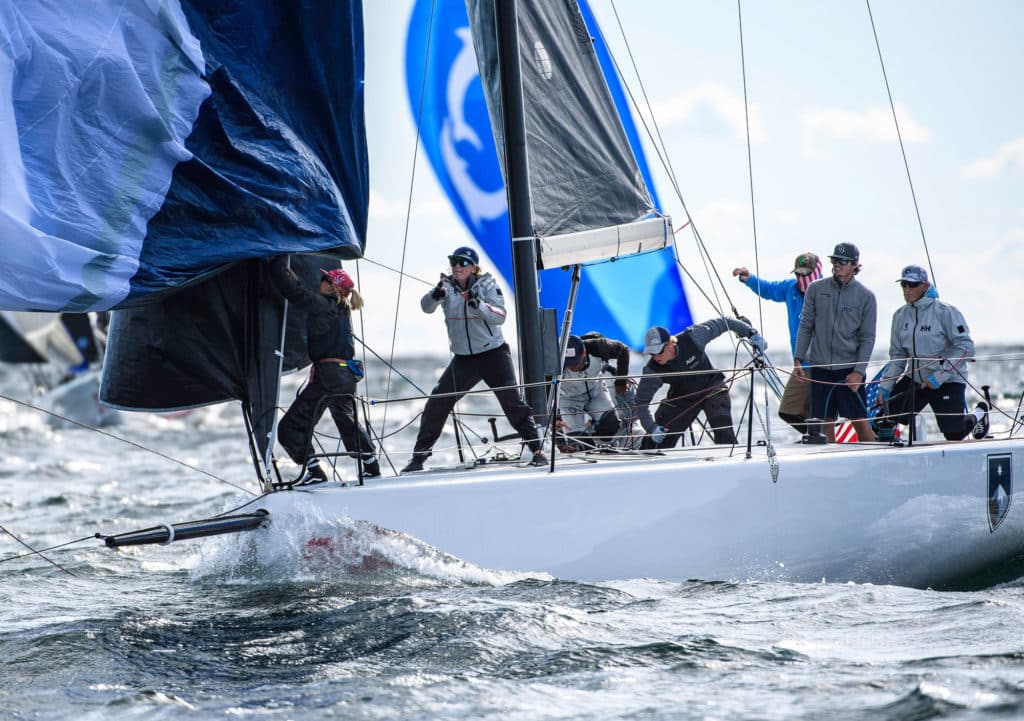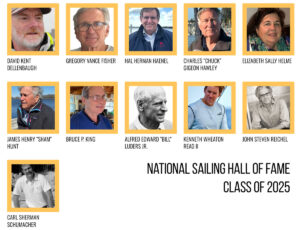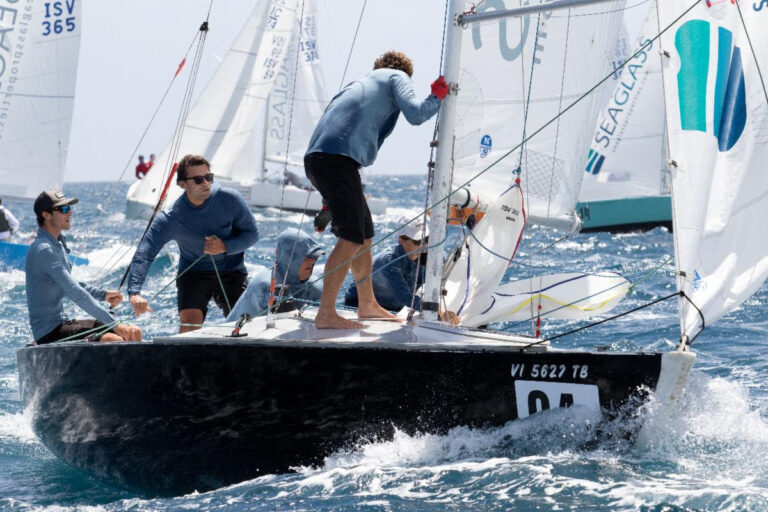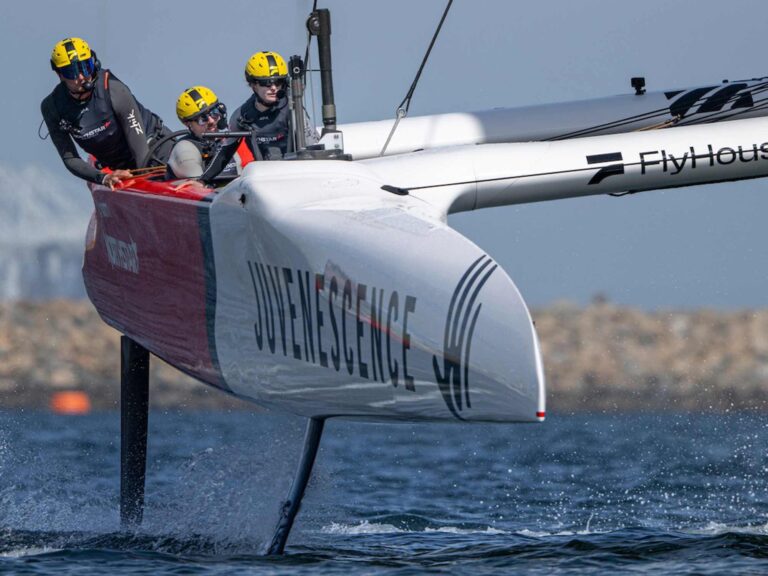
“The real problem with women’s sailing is that all the boats we sail are made for men.” A guy recently said this to me after telling me how big a proponent he is of women in sailing. This wasn’t the first time I’d heard this argument, and I was frustrated later when a few of my male friends told me they thought he made a good point. It led to a familiar set of questions: Do I really think the average woman is strong enough to trim the main on a keelboat or an E Scow? What percent of women do I think are strong enough to pump a kite in 20 knots?
Many people believe this is why sailing is such a male-dominated sport. Sailing is physically demanding, and as they see it, the average woman isn’t strong enough. If only we sailed boats that were smaller and more manageable, we’d have more women sailing. This perspective is frustrating because it’s a distraction. Sure, the average woman is not as strong as the average man. But that’s not why there are so few women in sailing. No one builds out sailing teams by picking average men and women off the street.
“In adult sailing, the most prevalent way women are overlooked is in crew decisions. It’s too common for women to be asked to round out a team in a way where the men expect minimal contribution to the sailing from them. When women aren’t expected to contribute more than being the right weight, it’s harder for them to develop the skills for other jobs. And it reinforces the misguided perception of women’s limited roles in the boat.”
The real issue is that people in the sailing world overwhelmingly underestimate female sailors’ abilities. If we want more women in sailing—which I believe most sailors do—we need to stop acting like a lack of women in the sport is inevitable. Instead, we need to address the underestimation of women. It’s not some inherent difference in natural strength that drives the gender gap; it’s the inherent difference in how women are treated.
From junior sailing through adult racing, girls and women have to work harder to establish confidence and earn respect. In spite of notable progress, our community still expects less of women than it does of men on the water. That affects what opportunities women have to sail. It affects how women are treated when we sail. And it affects everyone. My friends and I talk about it often. But its effects are even more harmful on those who probably don’t talk about it: young girls who don’t realize that their confidence and sense of belonging in our sport are so often undermined—subtly but surely—by underestimation. If we really want to grow women’s sailing and foster equality in our sport, we need to better understand this issue and shift our culture around it.
Data Reveals the Reality
Although women are breaking more glass ceilings in the sport every year, the reality is that there are still proportionately few women sailors. A friend of mine, Johanna Kincaid, used her data-science skills to help me understand these proportions. Kincaid wrote code that pulled registration information posted on the widely used regatta registration platform Yachtscoring from August 2020 through September 2021 and tracked the gender of registrants alongside other data points. What we found was interesting, but not surprising.
Only 16 percent of competitors across all regattas were women. Many classes were even more male-dominated. Eleven percent of classes had less than 5 percent women. Only 12 percent of classes had more than 30 percent female participation, and less than 1 percent of classes had more than 50 percent women. The vast majority of sailors (78 percent) are competing in classes that have less than 20 percent women. The trend gets even worse in professional sailing. Based on World Sailing classifications, only 5 percent of professional (Group 3) sailors competing at regattas in our data were women.
None of this data should be shocking; a quick glance around any boatyard is enough to see that there are mostly men there. But it’s useful, I think, to start with the numbers. When I talk about the gender gap or the gender disparity in sailing, this is what I mean. Sailing is a disproportionately male sport.
How We Underestimate Women
It’s time to move past the easy—and inadequate—explanation of this imbalance as the natural result of women being smaller. In the many conversations I’ve had with women about the challenges of being a woman in sailing, no one has ever said they were too small or weak for the positions they wanted. Instead, what comes up over and over again is the way women are overlooked, underrated and condescended to by men in the sailing world. It’s well within our power to go to the gym and be as strong as we need to be. Changing attitudes and culture is more difficult.
The need for this change is highlighted by the fact that girls in junior sailing drop out of the sport at a higher rate than boys. Size and strength don’t explain this; boys aren’t bigger or stronger than girls at that age. It’s far more likely that cultural factors, like the expectations we have for girls and the role models young sailors have, are driving this trend. These are often subtle factors, but they’re deeply impactful.
In adult sailing, the most prevalent way women are overlooked is in crew decisions. It’s too common for women to be asked to round out a team in a way where the men expect minimal contribution to the sailing from them. When women aren’t expected to contribute more than being the right weight, it’s harder for them to develop the skills for other jobs. And it reinforces the misguided perception of women’s limited roles in the boat.
If they want to have skilled positions, women often have to prove themselves to gain respect in any new context. The pathways into new fleets, especially high-performance and professional ones, are much harder. I know of women with All‑American collegiate titles who gave up on professional sailing as they watched men who they beat handily through college pick up higher-paid positions much more easily. A friend of mine—a four-time collegiate All‑American, among other accolades—was once asked to “whisper in the ear” of the tactician when the team’s captain realized they were wasting her skill by having automatically put her on runners. That she was a more skilled tactician than the guy with the job would have been obvious if the captain had considered her résumé before setting the roles. But in that fleet, the women are usually on runners.
In general, women are often overlooked. As a go-to person in my area to connect people with crew, I can’t count how many times I’ve been asked to find a “jib guy” or a “spinnaker guy.” These skippers aren’t trying to exclude women—they’d be happy with any skilled guy or girl I found for them. But there’s no doubt about who they’re picturing when putting a team together.
In addition to affecting what opportunities are available to women in sailing, the underestimation of women affects how women are treated on the water. If you’re ever looking to spark conversation, ask a group of women sailors about whether they’ve been disrespected or talked down to by men in the sport. The stories they’ll tell are all instances that give the messages, some subtly and some less so, that women are not seen as being as capable as men in sailing and are not taken as seriously.
Take, for example, when I was sailing a national championship where someone was filming for a documentary. After the videographer interviewed me, he pinched my cheek and told me he was looking forward to including my “cute little interview” in the documentary. The condescension is not always this obvious, but it is frequently present. Like when a friend of mine—an experienced sailor who knows her way around sail trim—had a guy constantly reach over her to adjust her jib sheets. He did this even as the mainsail he was trimming luffed due to his inattention.
It’s almost too cliché to bring up a friend who managed to get a paid spot on a high-performance race team but, as the only woman on the boat, was expected to clean coolers and make everyone’s lunches in addition to her regular jobs. Or when a friend asked for help replacing a woman on his boat, but then described the desired qualifications as young, blonde and fun at parties. Or when a friend found out midseason that she was the only person not being paid on the boat, even though the only difference between her and the rest of the crew was that she was a woman. The stories are endless.
The Push-Out Effect
These types of instances do more than just frustrate women by reminding them how hard it is to earn respect in the sport as a woman. They also contribute to an unjustified lack of confidence among women themselves. Until now, I’ve been talking about the women I know who continue to sail, and still excel. But my point is more focused on the women lost. Who isn’t sailing anymore, and why? I believe that a confidence deficit, caused in large part by the overall gender gap, plays a significant role in the answer.
For the past five years, I’ve run a regatta called Lady Drivers in the E Scow fleet. I started it hoping I could encourage more women to take up skippering in the male-dominated class. Almost every woman I’ve encouraged to sail the regatta has told me she didn’t feel comfortable taking the tillers of a boat as big and fast as the E Scow. But in the five years of sailing the regatta, there’s never been an incident that proved those fears right; it turns out, women are entirely capable of driving E Scows. They just usually have to be talked into it.
The male-dominated nature of sailing sets the stage for women to feel out of place. One of the biggest factors contributing to imposter syndrome—the persistent feeling of incompetence—is being a minority within a given field. But this is exacerbated by the reality that women sailors don’t get the same respect as the men they sail with and against. Whatever gender gap in confidence there may be at a baseline, this dynamic elevates it exponentially. How can I be surprised when women tell me they don’t feel confident driving an E Scow when I know that women in the sport consistently get the message that they are not as competent?
I think this message reaches the girls dropping out of the Opti class. It makes me think of a recent moment when I pulled my coach boat behind a young girl—likely just out of the green fleet—and asked her to luff so we could fix some issues with her rigging. I hadn’t coached her before, and the first thing she said to me was, with a resigned sigh: “I’m not very good at sailing.” She said it as if I should accept that as an unchangeable fact of life, and just let her sail on with her sprit about to fall off and several sail ties dangling loose.
“Most sailors want to see more women in the sport, but after talking about this with many people, I’ve realized there’s a major disconnect between how men and women see the problem.”
I can understand why she thought I was wasting my time because she was a “bad sailor.” She’d never been in the front of a fleet during a race—although, that’s true of most kids her age. But she’d probably rarely, if ever, met a female racing coach. Whatever exposure she had to famous sailors, it’s fair to guess that those sailors were men. When girls her age look “up” in the sailing world, they’re going to see mostly men. Because, as our numbers show, that’s mostly who’s there. No matter how much we celebrate the women in our sport, there’s no hiding their minority. So, it takes that much more imagination and self-confidence on the part of young girls to believe that this is a sport they can be good at and this is a community in which they belong.
When they start out racing, kids are going to struggle. What gets them through is a combination of being motivated to improve and believing they can improve. Both are necessary. Both are affected by the gender gap. If a young girl doesn’t have coaches and role models she can see herself in, she’s less likely to find that motivation. And if she looks around and sees mostly men on the elite professional teams, mostly men coaching, and mostly men throughout the sailing world, it’s hard to imagine she won’t on some level internalize the idea that men are better at this.
While these factors start affecting girls as early as their junior sailing days, their impact continues—and possibly heightens—in adult sailing. The sexism at play in who is asked to crew plays a substantial role in women dropping out of sailing even after successful college careers.
One pathway out of the sport is a gentle exit as confidence and interest decline. Women who were once confident—and often excelled—in junior sailing never fully make the transition into bigger boats. They’re sometimes brought on to crew, but usually for the least skilled positions. The people they sail with don’t expect much of them or invest energy in training them, and they never develop confidence in the boats. Eventually, they find themselves less excited about spending their time sailing.
Another pathway is more direct: Women get tired of putting up with sexism, so they stop wanting to sail where they experience it. I’ve had a few friends say as much to me in the past year. One friend responded to an Instagram story I posted about the need to create more opportunities for women in sailing by saying: “This is true, but it’s more the men in the sport that make me want to quit.” Another friend told me about how a few consecutive weekends when she sailed with guys who constantly talked down to her made her decide to spend more time on her other sports. Both women are talented and accomplished sailors who’ve just had enough of this culture.
The experiences I’m sharing are nearly universal to women in our sport. I can’t speak for everyone, but every woman I’ve talked to about this has said that it resonated. We usually shrug these things off when they happen. Partly because you have to pick your battles, but mostly because it’s more fun to sail and hang out with your friends than to call out sexism all the time.
It’s worth it to call it out sometimes, however. Most sailors want to see more women in the sport, but after talking about this with many people, I’ve realized there’s a major disconnect between how men and women see the problem. With women, the conversation always goes to the themes I’ve described. But I’ve never once talked to a guy who identified these as problems. Men usually either say they didn’t know why there are so many more men in sailing, or that it’s just the natural result of women not being big or strong enough for the boats we sail. If we want more women in our sport, we need to approach an understanding of why we have this problem in the first place.
There are many positive forces of change in women’s sailing. The Olympics have finally reached equity, with as many spots for women sailors as men. The Pan American Games recently added a new women’s-only Sunfish division and required that Lightning crews have at least two women. The Opti class allocates a number of spots on international teams for girls and runs a girls’ Nationals every year. The J/70 class is hosting its first “Mixed-Plus” division this winter, requiring all teams to have at least two women. There’s a burgeoning women’s team race circuit in keelboats. The list goes on; people are doing good things throughout the sailing world to promote women’s sailing.
As we celebrate these steps, however, I think it’s important to recognize why they’re necessary. Creating these women-specific opportunities is essential because women are so often overlooked in coed sailing. Encouraging young girls is important because the imbalances in the sailing world make it harder for girls to feel confident and see a future for themselves in the sport. We shouldn’t resign ourselves to losing the “girlie girls” from sailing. There’s no good reason for femininity to be at odds with our sport.
Looking forward, we should all question the idea that the biggest challenge to women’s sailing is that the boats we sail are built for men. The truth is I haven’t met a woman who couldn’t solve a strength challenge with a bit of time in the gym. But there’s not as clear a remedy to the structural, cultural issues that cause so many in our community to overlook women’s abilities. I’m tired of arguing about whether women are strong enough. Because there’s nothing masculine about being strong enough to pump a kite in 20 knots.
Kelly McGlynn hails from Little Egg Harbor YC (New Jersey), sailed for Brown University as a two-time Academic All‑American, graduating in 2015, and is now a lawyer. McGlynn regularly races E Scows and recently joined the Melges 15 class. The inspiration for this column was a conversation with her Brown teammate Megan Grapengeter-Rudnick about why they’ve seen so few women at regattas since college. “I hope people think differently about it and put some thought into what we take for granted,” she says. “This notion that there’s just more men around and that’s just how the sport is. I hope this helps start the conversation.”









